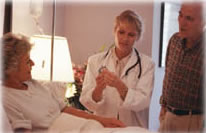


   |
Necrobiosis Lipoidica Diabeticorum
Definition Necrobiosis lipoidica diabeticorum is a rash that occurs on the lower legs. It is more common in women, and there are usually several spots. In 1929, Oppehhein first described necrobiosis lipoidica diabeticorum and called it dermatitis atrophicans lipoidica diabetica, but it was later renamed necrobiosis lipoidica diabeticorum by Urbach in 1932. NLD is much more common in diabetics, who account for perhaps 2/3 of all cases. Many of the remainder develops diabetes, and NLD should be considered a warning sign of diabetes. Reports vary widely on exactly who is most at risk. About 1% of diabetics have some degree of NLD ... plus or minus 1%, depending on which report you read. Some reports say NLD occurs more often in young women, but some textbooks disagree. It is disease of the dermal connective tissue characterized by the development of erythematous papules or nodules in the pretibial area. The papules form plaques covered with telangiectatic vessels. Causes
Symptoms
Treatment
| |
Online Doctor || Teeth Care || Contact Us || Diabetes Care || Cellulite Guide || Chemotherapy || Acne Products ||
|
|
(c) Online-family-doctor.com All rights reserved
Disclaimer: Online-family-doctor.com is an information and educational purposes web site only. It is not intended to treat, diagnose, cure, or prevent any disease. Do not rely upon any of the information provided on this site for medical diagnosis or treatment. Please consult your primary health care provider about any personal health concerns. We will not be liable for any complications, or other medical accidents arising from the use of any information on this site.